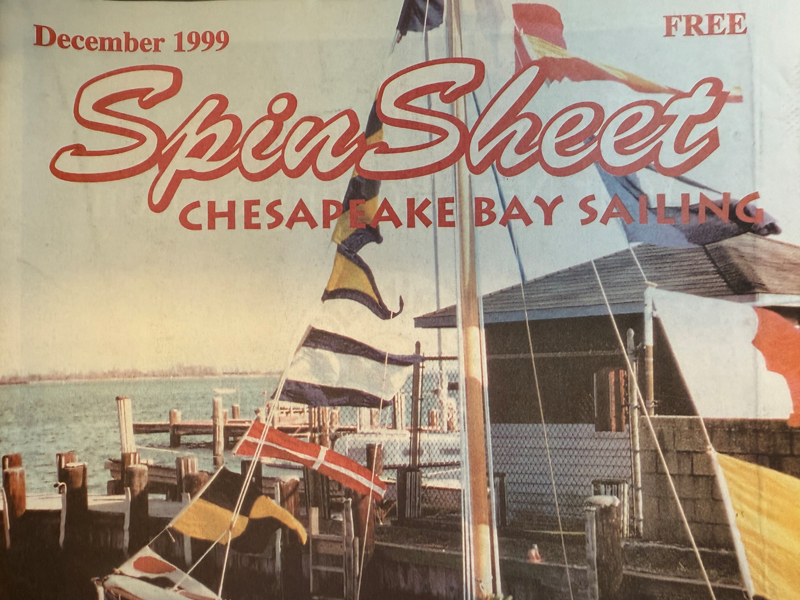To celebrate the 30-year anniversary of SpinSheet, we’re sharing stories from the archives. Back in December 1999, when founding editor Dave Gendell penned these historical musings in his editor’s note, SpinSheet’s pages were still all black and white except for a few select advertisements. Astute Chesapeake readers will note that some of the longtime regattas noted have morphed into something new or sailed into the sunset:

The final issue of SpinSheet of the millennuium
Welcome to the final issue of SpinSheet of the year/decade/ century/millennium… While 1900 is a few generations behind us, some things have not changed in the last 100 years. Hartges still live along the shores of the West River. Oxford, St. Michaels, and Gibson Island are still centers of sailing activity. It is still tough to get into creeks after a hard northwest blow. The stretch of the Severn River where in 1879 Albert Michaelson first accurately calculated the speed of light is still 2000 feet long—give or take a 10th of an inch.
Have you ever seen the special Newport to Bermuda chart? This is the chart with the sliver of North America in the upper left corner and a sliver of Bermuda in the lower right corner. On the edge of the chart is a picture of a boat. But it’s not just any boat; it’s Carleton Mitchell’s Finisterre. It seems odd to put a boat on a chart, but Finisterre was no ordinary boat. The Annapolis-based Mitchell and the crew of his Annapolis-based “heavy, fat anomaly,” Finisterre, a 38-foot Sparkman Stephens-penned yawl, won an unimaginable three consecutive Newport to Bermuda Races (1956, 1958, and 1960). Finisterre was a shoal draft centerboarder with a comfortable cabin and amenities including a record player. She was extraordinarily well-sailed, and her legend will not soon be forgotten. The honor roll of 20th century Chesapeake resident boats is chock full of names that helped define our sport: Eleanor, Kelpie, Finisterre, Freedom, Royono, Highland Light, Vamarie, Rubicon, Gaylark, Stormy Weather, Alaris, Running Tide, Constellation, Prim, Second Chance, American Eagle, along with a series of boats called Merrythought, Reindeer, Mist, and Babe.
Boats with a 20th century Chesapeake pedigree include the Comet, Mobjack, Chesapeake 20, Penguin, Hampton One Design, various Owens and Dickerson boats, and more recently, the designs of Annapolis-based Farr Yachts.
The Chesapeake Bay Yacht Racing Association (CBYRA) was incorporated in 1914 and instantly provided a modicum of organization and efficiency to the Bay’s recreational sailors. Today CBYRA is a volunteer organization that counts more than 70 member clubs in its ranks. The longevity of classes, clubs, and events is especially impressive. The Star class organized on Gibson Island and in Norfolk in 1923. CBYRA Annapolis Race Week has been contested 33 times. The Fall Naval Academy Sailing Squadron Annapolis to Oxford Race has been sailed 45 times. The Sailing Club of the Chesapeake’s Spring Race has been contested 50 times. The Corsica River YC has hosted an Annual Summer Regatta for 58 years. Potapskut SA has hosted a Queenstown Race and an Overnight Race for 60 years. The Hampton One Design class has sailed its National Championships 65 times. There has been a summer regatta on the Tred Avon River off Oxford for 68 years. And of course, there are a few log canoes that have sailed every summer of the century.
The advent of fiberglass production boats in the late 1960s and the early 1970s was certainly a watershed event that brought many individuals and families into the sport that would otherwise be watching from the shore. Fiberglass boats were affordable and required far less care and feeding than their wooden predecessors. Suddenly, sailing was accessible to a much larger group of people, and the energy and focus the masses brought to the sport have benefited everyone. Materials such as dacron and aluminum also contributed to this revolution as did events such as the Annapolis Sailboat Show and the boom in sailing schools. Now it was possible for anyone to “become a sailor in one weekend.”
We recommend Richard “Jud” Henderson’s book “Chesapeake Sails: A History of Yachting on the Bay." No sailor’s library should be without a copy.




